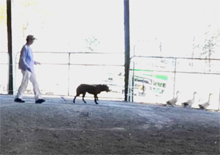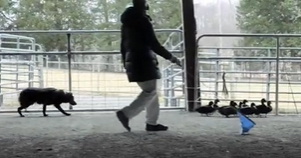| Step By Step Method | |
| Step 1. | Starting Your Puppy |
| Step 2. | Advancing Your Basics - Pace, Getting stock off a fence, Starting Outruns |
| Step 3. | Driving. |
| Roxy's Progress At One Year of Age | |
| Questions & Possible Solutions | |
![]()
Driving
Dogs either take stock to a handler, aka fetching, or taking stock to a destination where the handler commands a dog to, aka driving. We’ve introduced the pup to driving with ABCs walking up to stock on line since the very start of their training as seen in prior videos. That’s one way to practice driving but there are so many more ways to teach the pup the idea of taking stock away rather than fetching it to a handler. I’ve shown driving to the pup online to pushing the sheep off the feeders. Driving on a line with the handler staying up with the pup’s shoulder is what we started with in ABCs and you can continue this method even in larger areas. As you move to bigger areas I suggest driving on the fence line because the fence does half the job for the dog making it simpler for you to get your point across to the pup. A line permits you to show the dog what you are looking for without a lot of unconstructive behaviors seeping in from the dog. Strong fetching dogs tend to want to go to the fence and take stock off to fetch to the handler. The line helps hold the dog’s position on the inside eye of the ducks rather than letting the dog go to the outside eye of the duck on the fence line which will result in fetching the stock to the handler.
While driving with the pup on line, try to step laterally away from the pup rather than letting the pup get ahead of you. This is the same idea as you stepping laterally away from the pup’s flanks but staying up at their shoulder rather than letting the pup leave getting ahead of you where it is easier for them to spiral inwards on their flanks. Remove yourself from the situation laterally, letting out a little line and extinguishing your presence from the situation, to see if the pup can carry out the drive without your pressure on the stock. You have the line in your hand so you can assist the drive as you remove yourself and if things go wrong, simply get closer to the pup and shorten your line. When you are laterally across for dog, you can make sure the pup squares properly when trying to fix the straightness of the drive.
As the pup starts to get the idea that they are taking stock to a destination, a corner for exampIe, occasionally softly open your grip on the line and let the pup take a little line and get out in front of you as long as they offer constructive behaviors. Since you still have the line you can reinforce downs or tug on the line to make sure the dog squares off driving flanks and doesn’t keep going forward and slicing the flanks (going forward while flanking) which is counterproductive to precise steering of stock. If all is going really well drop your line and let the dog drag it and pick it back up if necessary. If at any point the pup has been allowed to drive out in front of you and looks back, immediately step up laterally across from the pup’s eye so they can see you in their peripheral vision and won’t need to look back to find you for support. You want the pup to focus on their stock and never take their eye off of it. Looking back at a handler is an indication that the pup has lost confidence and certainly has taken their eye off the stock. By moving out of the picture laterally, the pup can see you while still watching their stock. You can either give out more line or drop it for wider and wider flanks on the ends of the drive and pick it back up to drive.

Roxy is getting the idea of driving well enough now that I’m letting her drive without holding the line. I choose to train cross driving first because I can help keep the ducks on the fence, influence the dog’s flanks, downs and the pup can always see me which is reassuring. The handler, dog and stock create a triangle of sorts. The stock is one point of the triangle, the dog is the second and the handler is off to the side, the third point behind the eye of the stock and in front of the eye of the dog. The handler should be closer to stock than the dog because the dog is always going to the stock. The handler being high on the stock keeps the handler in the dog’s visual field so the dog isn’t looking back at the handler and keeps their attention on the stock. The dog can see their handler in their peripheral vision as they concentrate on the stock. The handler being higher than the dog to the stock also gives the handler the advantage to influence the dog’s stops and square flanks if necessary.
If the dog fades towards the fence to fetch the ducks to handler, I can either flank her away from the fence or I can call her out to encourage her to stay on the inside eye of the ducks holding them on the fence.
In a true drive the dogs work in front of the handler and must be totally verbal and not rely on the handler’s position or their body position for instructions. People don’t realize how much dog’s rely on the handler’s body language and positioning rather than verbal commands in the beginning of their training. It takes a long time for dogs to become totally verbal and understand commands in any and every situation and context on the field. True driving in front of a handler requires a totally verbal dog.



